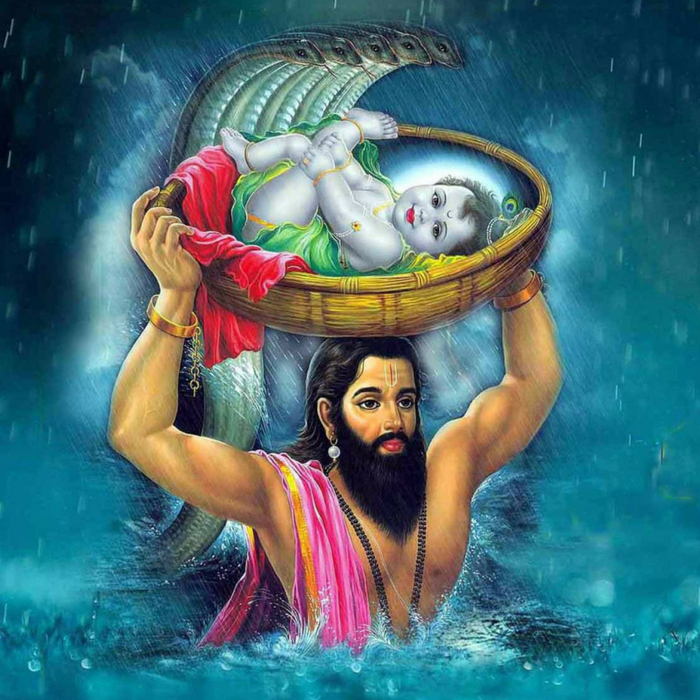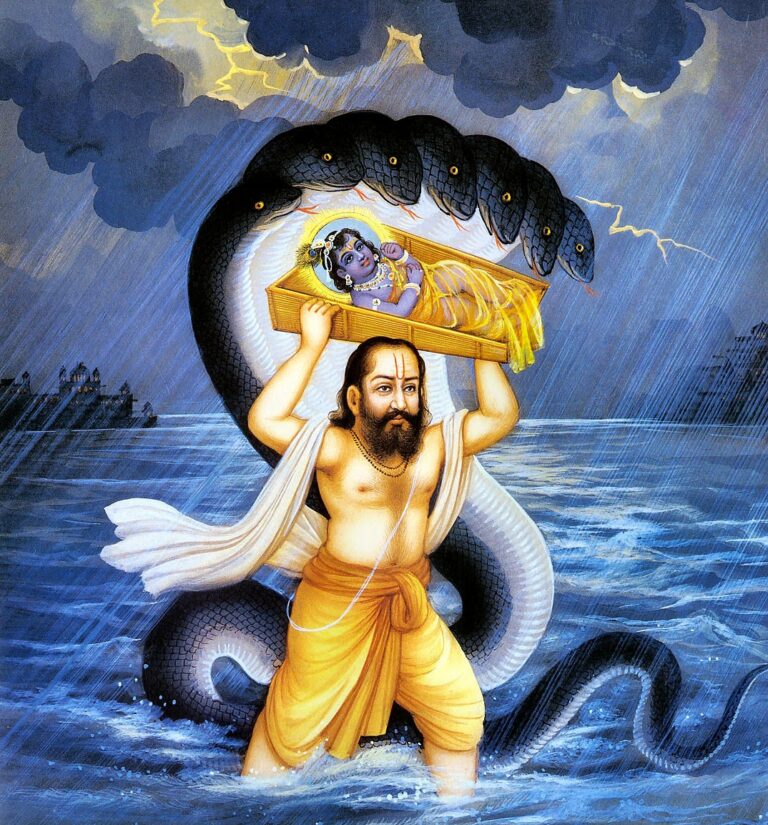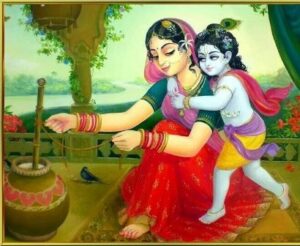🌼 Krishna Janmashtami 🌼

॥ ॐ श्री परमात्मने नमः ॥
🚩 Krishna Janmashtami 2024 🚩

About Aatham(Krishna Janmastami)
Krishna Janmashtami is also known as “Krishnashtami “,”Saatam Aatham” ,”Gokulashtami”, “Ashtami Rohini”, “Srikrishna Jayanti”, “Sree Jayanthi” or sometimes merely as “Janmashtami”, is a Hindu festival celebrating the birth of Lord Krishna, an avatar of hindu deity Vishnu.
In Shravana Masa (as per the amanta tradition) or Bhadrapada Masa (as per the purnimanta tradition), people commemorate and celebrate the birth of Krishna on the eighth day (Ashtami) of the dark fortnight (Krishna Paksha). The Gregorian months of August or September coincide with this.
The Vaishnavite tradition of Hinduism holds great significance for this event. A festival is held in observance of Janmashtami, along with reading and reciting religious texts, dancing, acting out Krishna’s life as told in the Bhagavata Purana, devotional singing until midnight (the time of Krishna’s birth), and fasting (upavasa), among other celebratory customs. India and other countries celebrate it widely.
***
✨Krishna Janmashtami Puja Vidhi:✨
The puja vidhi of this festival is very important as the birth of Laddoo Gopal is the focal point of all preparations. To ensure that you get the most out of this puja, we have provided a detailed puja vidhi below:
- Take a bath in the morning and wear clean clothes.
- Start the puja preparations at night by decorating Shri Krishna’s cradle and cleaning the temple with Gangajal.
- Keep this thing in mind before starting the puja. Place the idol of Lord Krishna respectfully on the cradle. If you do not have a cradle, you can also use a wooden stool.
- Pouring water at the feet of the Lord is called padya. Offer arghya to the Lord.
- Perform achamana, which is the act of offering water to the Lord and then drinking it.
- To perform the Lord’s bath ceremony, pour the five ingredients of panchamrit on the idol: milk, curd, honey, ghee and Gangajal.
- Collect the five ingredients, then prepare panchamrit using them later as prasad.
- Adorn the idol with new clothes and accessories which is called the deity’s Shringar.
- Offer the holy Janeu to the Lord. Then apply sandalwood paste on the Lord.
- Adorn the idol with a crown, jewelry, peacock feathers, and a flute.
- Offer flowers and Tulsi leaves to the Lord. Light an incense stick and an oil lamp.
- Offer butter and sugar candy to the Lord. Offer Tamboolam made of coconut, betel nut, turmeric, paan, and kumkum to the Lord.
- Sing Kunj Bihari Aarti in honor of the Lord and then perform parikrama.
- Fold your hands and pray to the Lord to keep you and your family safe from all calamities.
***
🍀Legends associated with Krishna Janmashtami🍀
When Devaki gave birth to her eighth son, the kingdom of Mathura was plunged into silence due to divine intervention. Vasudeva took advantage of this situation and took his infant out of Mathura. Krishna was carried in a basket in heavy rains. Sheshnag, who is known as the king of snakes, protected the two with his five-headed hood. With the help of divine powers, Vasudeva was able to cross the Yamuna River and reach Gokul. Vasudeva brought his son here and left him with his foster parents Yashoda and Nanda.
Yashoda, on the other hand, had given birth to a girl who was believed to be the incarnation of Goddess Durga. Vasudeva took the newborn girl back to Mathura. He deceived Kansa into thinking that the prophecy of his death at the hands of Devaki’s eighth son was false, which made him feel relieved and happy. Every year, devotees celebrate the festival of Janmashtami with great zeal and enthusiasm on the birth of their lord and protector Krishna.
***
🦚Rituals performed during Krishna Janmashtami🦚
The rituals performed on Krishna Janmashtami have a lot to do with why people of all ages love this festival. Some of the important practices associated with this day are as follows:
- Devotees observe a full day fast on the occasion of Krishna Janmashtami. The entire day is spent remembering the Lord and the fast ends at midnight, which is believed to be the time of Lord Krishna’s birth.
- Devotees chant the Lord’s name throughout the day and fill the atmosphere with their devotion and dedication. A lot of devotional songs are sung, especially in Krishna temples.
- Plays detailing the life story of Krishna and his various leelas are performed. Children dressed in the costumes of Krishna and his gopis perform Raasleela.
- Lord Krishna loved butter, so it is a must-have dish. To please little Gopal, devotees offer sweets made of milk, dry fruits, sugar and khoya.
- To help us remember Krishna’s teachings and the meaning of life, passages from the Bhagavad Gita are recited aloud.
***
Krishna Janmashtami 2024 Date and Time:
Shri Krishna Jayanti Yoga
5251st Birth Anniversary of Lord Krishna
Krishna Janmashtami: Monday, August 26, 2024
Nishita Puja Time – 12:33 AM to 01:18 AM, Aug 27
Duration – 00 Hours 45 Mins
Dahi Handi on Tuesday, August 27, 2024
Parana as per Dharma Shastra
Parana Time: after 03:38 PM, Aug 27
On Parana Day Rohini Nakshatra End Time: 03:38 PM
On Parana Day Ashtami got over before Sunrise
Alternate Parana as per Dharma Shastra
Parana Time – after 06:35 AM, Aug 27
Parana can be done on the next day sunrise after Deva Puja, Visarjan etc.
Parana as per modern tradition in society
Parana Time – after 01:18 AM, Aug 27
at many places in India, Parana is done after Nishita i.e. Hindu midnight
Mid Night Moment – 12:56 AM, Aug 27
Chandrodaya Moment – 12:11 AM, Aug 27 Krishna Dashami
Ashtami Tithi Begins – 03:39 AM on Aug 26, 2024
Ashtami Tithi Ends – 02:19 AM on Aug 27, 2024
Rohini Nakshatra Begins – 03:55 PM on Aug 26, 2024
Rohini Nakshatra Ends – 03:38 PM on Aug 27, 2024
🌷🌼🌻
Krishna Janmashtami:

🌼Significance of Krishna Janmashtami🌼
According to Hindu scriptures, Shri Krishna was born in the city of Mathura to Devaki and Vasudeva on the Ashtami tithi or the eighth day of the Krishna Paksha of Bhadrapada. Kansa, the demon king of Mathura, was Devaki’s brother. A prophecy stated that Kansa would be killed by Devaki’s eighth son because of his sins. Kansa therefore imprisoned his sister and her husband.
To prevent the prophecy from coming true, he attempted to kill Devaki’s children immediately after their birth. When Devaki gave birth to her eighth child, the entire palace went into a deep sleep by magic. Vasudeva was able to save the infant from Kansa’s wrath by taking him to Yashoda and Nanda’s home in Vrindavan during the night. This infant was a form of Lord Vishnu, who later assumed the name Shri Krishna and killed Kansa, ending his reign of terror.
***
🌼Krishna Janmashtami Around the World 🌼
Krishna Janmashtami is celebrated with great enthusiasm all over the world. Different states of India as well as countries around the world celebrate this festival in different ways.
North India: The biggest festival of North India is Janmashtami. On this day, people celebrate the tradition of Raas Leela. Another activity that takes place in Jammu on Krishna Janmashtami is kite flying.
Northeast and East India: On the day of Janmashtami, residents of Manipur perform Radha-Krishna Raas Leela, a dance drama inspired by love. Parents read aloud the Bhagavad Gita and the tenth chapter of the Bhagavata Purana while dressing their children as Krishna from the stories of the gopis and Krishna.
West Bengal and Odisha: Another name for this festival is Shri Krishna Odisha. On the day of Janmashtami, people fast and worship till midnight. People recite the 10th verse of the Bhagavata Purana, which is dedicated to the life of Krishna. The next day is celebrated as ‘Nanda Utsav’, which is a festival honoring Krishna’s foster parents, Nanda and Yashoda.
Rajasthan and Gujarat: In Gujarat, the ritual of Makhan Handi is celebrated on the occasion of Krishna Janmashtami, which is similar to the Dahi Handi ritual. Some people perform folk dances, sing bhajans and visit temples of Lord Krishna.
Maharashtra: Every year in August, people celebrate Janmashtami, which is also known as Gokulashtami. The Dahi Handi festival is celebrated on the next day of Krishna Janmashtami. On this day, people break the Dahi Handi which is an earthen pot filled with curd. According to mythology, baby Krishna stole butter and curd, so that people keep their milk products out of Krishna’s reach.
Krishna used to think of various creative ways to knock down these high-hanging pots, like forming human pyramids with his friends. Thus, was born the idea of Dahi Handi, with the fallen contents being called Prasad.
South India: Gokula Ashtami is celebrated with great enthusiasm in South India. In Tamil Nadu, kolams are used to decorate the floor, and Krishna-honoring devotional songs are sung. To signify Krishna’s entry into the house, they draw Krishna’s footprints from the entrance to the puja room. Butter, betel leaves and fruits are offered to Krishna.
***
🌼Mantra For Krishna Janmashtami:🌼
दिने दिने नवं नवं नमामि नन्दसंभवम्।
dine dine navaṃ navaṃ namāmi nandasaṃbhavam।
English translation:
Every day in new ways, I worship Nandkumar.
***
ईश्वरः परमः कृष्णः सच्चिदानन्दविग्रहः।
अनादिरादिर्गोविन्दः सर्वेकारणकारणम् ॥
īśvaraḥ paramaḥ kṛṣṇaḥ saccidānandavigrahaḥ।
anādirādirgovindaḥ sarvekāraṇakāraṇam॥
English translation:
Lord Krishna, who is known as Govinda is the Supreme Godhead. He has an eternal, blissful, spiritual body. He is the origin of all. He has no other origin, and He is the prime cause of all causes.
***
भजे व्रजैकमण्डनं समस्तपापखण्डनं स्वभक्तचित्तरञ्जनं सदैव नन्दनन्दनम्।
सुपिच्छगुच्छमस्तकं सुनादवेणुहस्तकं अनङ्गरङ्गसागरं नमामि कृष्णनागरम्॥
bhaje vrajaikamaṇḍanaṃ samastapāpakhaṇḍanaṃ svabhaktacittarañjanaṃ sadaiva nandanandanam।
supicchagucchamastakaṃ sunādaveṇuhastakaṃ anaṅgaraṅgasāgaraṃ namāmi kṛṣṇanāgaram॥
English translation:
I worship the naughty Krishna, who is the joy of Nanda. the only ornament of Vraja, who destroys all the sins (of his devotees), who satisfies the desires of his devotees. Who wears a peacock feather on his head, who plays a flute with a sweet sound, and Who is the ocean of the art of love.
***